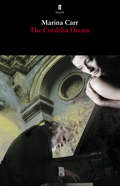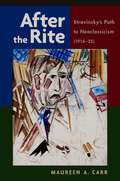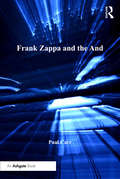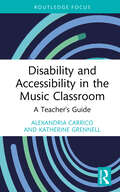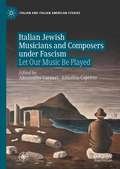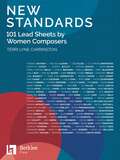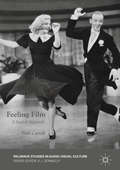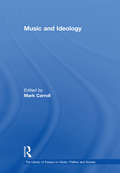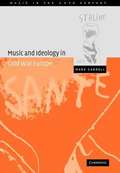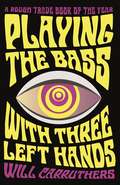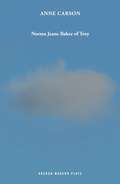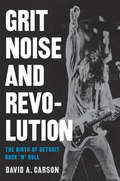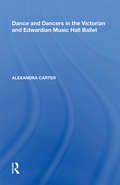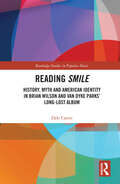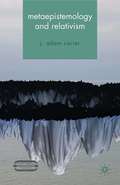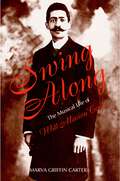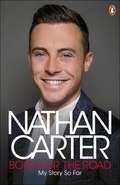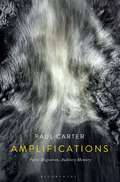- Table View
- List View
The Cordelia Dream: On Raftery's Hill; Ariel; Woman And Scarecrow; The Cordelia Dream; Marble
by Marina CarrHaunted by her dream of Cordelia and Lear, a woman confronts an elderly man, her lifelong antagonist and rival. During their passionate altercation he dismisses her success as a composer and demands she make the ultimate sacrifice: for him to flourish she, his protégée, must be silent. Five years later, she returns for a final and devastating encounter.Marina Carr's The Cordelia Dream premiered in December 2008 at Wilton's Music Hall, London, in a production by the Royal Shakespeare Company.
After the Rite: Stravinsky's Path to Neoclassicism (1914-1925)
by Maureen A. CarrThe riot that erupted during the 1913 debut of Igor Stravinsky's The Rite of Spring at the Théâtre des Champs-Élysées in Paris has long been one of the most infamous and intriguing events of modern musical history. The third in a series of works commissioned for Sergei Diaghalev's famed Ballets Russes, the piece combined disjunct tonalities, provocative rhythms, and radical choreography that threw spectators and critics into a literal fury. In the century following its premiere, The Rite of Spring has demonstrated its earth-shattering impact on music and dance as well as its immortalizing effect on Stravinsky and his career. Having gained international attention by the age of 30, what direction could Stravinsky's path forward take after the momentus events of 1913? After the Rite: Stravinsky's Path to Neoclassicism (1914-1925) traces the evolution of Stravinsky's compositional style as he searched for his own voice in the explosive musical world of the early 20th century as he responded to harsh criticisms of his work. Throughout the book, author Maureen Carr presents new transcriptions and sophisticated analyses of selected musical sketches to show the genesis of Stravinsky's musical ideas as he forayed into surrealism, classicism, and abstraction to develop his signature Neoclassical style. Exploring these annotated compositional experiments--such as the earliest evidence of Stravinsky's appropriation of the "rag idiom" and the development of his so-called "sound blocks"--After the Rite provides new insight into how Stravinsky challenged and guided the musical developments of the decade after that legendary Paris premiere. Enlightening visual metaphors, such as the contemporary paintings of Paul Klee and those of the Russian futurists, supplement discussion of the musical sketches throughout, offering a comprehensive artistic context for Carr's unprecedented and rigorous examination. A treasure trove of outstanding material for scholars, musicians, students, and general readers alike, After the Rite offers a much-needed delineation of the concept of musical neoclassicism. Maureen Carr's innovative and detailed examination of the metamorphosis of Igor Stravinsky's compositional style after The Rite of Spring is an invaluable contribution to the literature concerning this iconic 20th century composer.
Frank Zappa and the And (Ashgate Popular and Folk Music Series)
by Paul CarrThis collection of essays, documented by an international and interdisciplinary array of scholars, represents the first academically focused volume exploring the creative idiolect of Frank Zappa. Several of the authors are known for contributing significantly to areas such as popular music, cultural, and translation studies, with expertise and interests ranging from musicology to poetics. The publication presents the reader with an understanding of the ontological depth of Zappa's legacy by relating the artist and his texts to a range of cultural, social, technological and musicological factors, as encapsulated in the book's title - Frank Zappa and the And. Zappa's interface with religion, horror, death, movies, modernism, satire, freaks, technology, resistance, censorship and the avant-garde are brought together analytically for the first time, and approached non chronologically, something that strongly complies with the non linear perspective of time Zappa highlights in both his autobiography and recordings. The book employs a variety of analytical approaches, ranging from literary and performance theory, 'horrality' and musicology, to post modern and textually determined readings, and serves as a unique and invaluable guide to Zappa's legacy and creative force.
Frank Zappa and the And (Ashgate Popular and Folk Music Series)
by Paul CarrThis collection of essays, documented by an international and interdisciplinary array of scholars, represents the first academically focused volume exploring the creative idiolect of Frank Zappa. Several of the authors are known for contributing significantly to areas such as popular music, cultural, and translation studies, with expertise and interests ranging from musicology to poetics. The publication presents the reader with an understanding of the ontological depth of Zappa's legacy by relating the artist and his texts to a range of cultural, social, technological and musicological factors, as encapsulated in the book's title - Frank Zappa and the And. Zappa's interface with religion, horror, death, movies, modernism, satire, freaks, technology, resistance, censorship and the avant-garde are brought together analytically for the first time, and approached non chronologically, something that strongly complies with the non linear perspective of time Zappa highlights in both his autobiography and recordings. The book employs a variety of analytical approaches, ranging from literary and performance theory, 'horrality' and musicology, to post modern and textually determined readings, and serves as a unique and invaluable guide to Zappa's legacy and creative force.
Disability and Accessibility in the Music Classroom: A Teacher's Guide (Modern Musicology and the College Classroom)
by Alexandria Carrico Katherine GrennellDisability and Accessibility in the Music Classroom provides college music history instructors with a concise guide on how to create an accessible and inclusive classroom environment. In addition to providing a concise overview of disability studies, highlighting definitions, theories, and national and international policies related to disability, this book offers practical applications for implementing accessibility measures in the music history classroom. The latter half of this text provides case studies of well-known disabled composers and musicians from the Western Art Music canon from the Middle Ages to the Twentieth Century as well as popular music genres, such as the blues, jazz, R&B, pop, country, and hip hop. These examples provide opportunities to integrate discussions of disability into a standard music history curriculum.
Disability and Accessibility in the Music Classroom: A Teacher's Guide (Modern Musicology and the College Classroom)
by Alexandria Carrico Katherine GrennellDisability and Accessibility in the Music Classroom provides college music history instructors with a concise guide on how to create an accessible and inclusive classroom environment. In addition to providing a concise overview of disability studies, highlighting definitions, theories, and national and international policies related to disability, this book offers practical applications for implementing accessibility measures in the music history classroom. The latter half of this text provides case studies of well-known disabled composers and musicians from the Western Art Music canon from the Middle Ages to the Twentieth Century as well as popular music genres, such as the blues, jazz, R&B, pop, country, and hip hop. These examples provide opportunities to integrate discussions of disability into a standard music history curriculum.
Italian Jewish Musicians and Composers under Fascism: Let Our Music Be Played (Italian and Italian American Studies)
by Alessandro Carrieri Annalisa CapristoThis book is the first collection of multi-disciplinary research on the experience of Italian-Jewish musicians and composers in Fascist Italy. Drawing together seven diverse essays from both established and emerging scholars across a range of fields, this book examines multiple aspects of this neglected period of music history, including the marginalization and expulsion of Jewish musicians and composers from Italian theatres and conservatories after the 1938–39 Race Laws, and their subsequent exile and persecution. Using a variety of critical perspectives and innovative methodological approaches, these essays reconstruct and analyze the impact that the Italian Race Laws and Fascist Italy’s musical relations with Nazi Germany had on the lives and works of Italian Jewish composers from 1933 to 1945. These original contributions on relatively unresearched aspects of historical musicology offer new insight into the relationship between the Fascist regime and music.
Feeling Film: A Spatial Approach (Palgrave Studies in Audio-Visual Culture)
by Beth CarrollThis book questions the de facto dominance of narrative when watching films. Using the film musical as a case study, this book explores whether an alternative spatial understanding of film can offer alternative readings to narrative. For instance, how do film aesthetics influence our interaction with the film? Can camera movement and music make us ‘feel’ cinema? Can the film world bleed into our own? Utilising film musicals ranging from those by Fred Astaire and Ginger Rogers to von Trier’s Dancer in the Dark (2000), Feeling Film: A Spatial Approach investigates how we might go about understanding the audience's spatial relationship with film aesthetics, what it might look like, and the tools needed to conduct analysis.
Music and Ideology
by Mark CarrollThis volume gathers together a cross-section of essays and book chapters dealing with the ways in which musicians and their music have been pressed into the service of political, nationalist and racial ideologies. Arranged chronologically according to their subject matter, the selections cover Western and non-Western musics, as well as art and popular musics, from the eighteenth century to the present day. The introduction features detailed commentaries on sources beyond those included in the volume, and as such provides an invaluable and comprehensive reading list for researchers and educators alike. The volume brings together for the first time seminal articles written by leading scholars, and presents them in such a way as to contribute significantly to our understanding of the use and abuse of music for ideological ends.
Music and Ideology
by Mark CarrollThis volume gathers together a cross-section of essays and book chapters dealing with the ways in which musicians and their music have been pressed into the service of political, nationalist and racial ideologies. Arranged chronologically according to their subject matter, the selections cover Western and non-Western musics, as well as art and popular musics, from the eighteenth century to the present day. The introduction features detailed commentaries on sources beyond those included in the volume, and as such provides an invaluable and comprehensive reading list for researchers and educators alike. The volume brings together for the first time seminal articles written by leading scholars, and presents them in such a way as to contribute significantly to our understanding of the use and abuse of music for ideological ends.
Music And Ideology In Cold War Europe (Music In The Twentieth Century Ser. (PDF) #18)
by Mark Carroll Arnold WhittallThis book places the radicalization of art music in early post-war France in its broader socio-cultural and political context. It pursues two general and intersecting lines of inquiry. The first details the stances towards musical conservatism and innovation adopted by cultural strategists representing Western and Soviet ideological interests at the onset of the Cold War. The second, which draws upon the commentaries of Theodor Adorno and Jean-Paul Sartre, recognizes that the Cold War generated a heightened political awareness amongst French musicians at the very time when the social relevance of avant-garde music had become the subject of widespread debate. The study considers the implications of the performance at L'Oeuvre du XXe siècle, an international arts festival staged in Paris in 1952 with the intention of discrediting socialist realism by means of two opposing musical types: neo-classicism (represented by Stravinsky's Symphony in C) and serialism (Boulez's Structures 1a).
Playing the Bass with Three Left Hands
by Will CarruthersI can confirm that should you ever find yourself on stage playing the bass guitar with tree left hands, it is usually the one in the middle that is the real one. The other two are probably phantoms. Playing the Bass with Three Left Hands tells the story of one of the most influential, revered and ultimately demented British bands of the 1980s, Spacemen 3. In classic rock n roll style they split up on the brink of their major breakthrough. As the decade turned sour and acid house hit the news, Rugby's finest imploded spectacularly, with Jason Pierce (aka Jason Spaceman) and Pete Kember (aka Sonic Boom) going their separate ways. Here, Will Carruthers tells the whole sorry story and the segue into Spirtualised in one of the funniest and most memorable memoirs committed to the page.
Norma Jeane Baker of Troy (Oberon Modern Plays)
by Anne CarsonNorma Jeane Baker of Troy is a partly spoken, partly sung performance piece by poet, essayist, and scholar Anne Carson, and an exploration of the lives and myths of Marilyn Monroe and Helen of Troy—iconic beauties who lived millennia apart.A thrilling and thoughtful meditation on the destabilising and destructive power of beauty, this had its world premiere at The Shed in New York City, starring Ben Whishaw and Renée Fleming.
Grit, Noise, and Revolution: The Birth of Detroit Rock 'n' Roll
by David A. Carson". . . a great blow-by-blow account of an exciting and still-legendary scene." ---Marshall Crenshaw From the early days of John Lee Hooker to the heyday of Motown and beyond, Detroit has enjoyed a long reputation as one of the crucibles of American pop music. In Grit, Noise, and Revolution, David Carson turns the spotlight on those hard-rocking, long-haired musicians-influenced by Detroit's R&B heritage-who ultimately helped change the face of rock 'n' roll. Carson tells the story of some of the great garage-inspired, blue-collar Motor City rock 'n' roll bands that exemplified the Detroit rock sound: The MC5, Iggy Pop and the Stooges, Mitch Ryder and the Detroit Wheels, SRC, the Bob Seger System, Ted Nugent and the Amboy Dukes, and Grand Funk Railroad. An indispensable guide for rock aficionados, Grit, Noise, and Revolution features stories of these groundbreaking groups and is the first book to survey Detroit music of the 1960s and 70s-a pivotal era in rock music history.
Dance and Dancers in the Victorian and Edwardian Music Hall Ballet
by Alexandra CarterFirst published in 2005. The Victorian and Edwardian music hall ballet has been a neglected facet of dance historiography, falling prey principally to the misguided assumption that any ballet not performed at the Opera House or 'legitimate' theatre necessarily meant it was of low cultural and artistic merit. Here Alexandra Carter identifies the traditional marginalization of the working class female participants in ballet historiography, and moves on to reinstate the 'lost' period of the music hall ballet and to apply a critical account of that period. Carter examines the working conditions of the dancers, the identities and professional lives of the ballet girls and the ways in which the ballet of the music hall embodied the sexual psyche of the period, particularly in its representations of the ballet girl and the ballerina. By drawing on newspapers, journals, theatre programmes, contemporary fiction, poetry and autobiography, Carter firmly locates the period in its social, economic and artistic context. The book culminates in the argument that there are direct links between the music hall ballet and what has been termed the 'birth' of British ballet in the 1930s; a link so long ignored by dance historians. This work will appeal not only to those interested in nineteenth century studies, but also to those working in the fields of dance studies, gender studies, cultural studies and the performing arts.
Dance and Dancers in the Victorian and Edwardian Music Hall Ballet
by Alexandra CarterFirst published in 2005. The Victorian and Edwardian music hall ballet has been a neglected facet of dance historiography, falling prey principally to the misguided assumption that any ballet not performed at the Opera House or 'legitimate' theatre necessarily meant it was of low cultural and artistic merit. Here Alexandra Carter identifies the traditional marginalization of the working class female participants in ballet historiography, and moves on to reinstate the 'lost' period of the music hall ballet and to apply a critical account of that period. Carter examines the working conditions of the dancers, the identities and professional lives of the ballet girls and the ways in which the ballet of the music hall embodied the sexual psyche of the period, particularly in its representations of the ballet girl and the ballerina. By drawing on newspapers, journals, theatre programmes, contemporary fiction, poetry and autobiography, Carter firmly locates the period in its social, economic and artistic context. The book culminates in the argument that there are direct links between the music hall ballet and what has been termed the 'birth' of British ballet in the 1930s; a link so long ignored by dance historians. This work will appeal not only to those interested in nineteenth century studies, but also to those working in the fields of dance studies, gender studies, cultural studies and the performing arts.
Reading Smile: History, Myth and American Identity in Brian Wilson and Van Dyke Parks’ Long-Lost Album (Routledge Studies in Popular Music)
by Dale CarterFirst conceived in 1966 but only completed in 2004, Brian Wilson Presents Smile has been called "the best-known unreleased album in pop music history" and "an American Sergeant Pepper." Reading Smile offers a close analysis of the recording in its social, cultural and historical contexts. It focuses in particular on the finished work’s subject matter as embodied in Van Dyke Parks’ contentious yet little understood lyrics, with their low-resolution, highly allusive portrayals of western expansion’s archetypes, from Plymouth Rock, Massachusetts to Diamond Head, Hawaii. Documenting their multiple references and connotations, it argues that their invocations of national self-definition are part of a carefully crafted vision of American identity, society and culture both in tune and at odds with the times. Critical of the republic’s past practices but convinced that its ideals, values and myths still provided resources to redeem it, the recording is interpreted as a creative musical milestone, an enduring product of its volatile, radical, countercultural times, and an American pop art classic. Of particular relevance to American Studies and popular culture scholars, Reading Smile will also appeal to those interested in 1960s popular music, not least to fans of Brian Wilson, Van Dyke Parks and the Beach Boys.
Reading Smile: History, Myth and American Identity in Brian Wilson and Van Dyke Parks’ Long-Lost Album (Routledge Studies in Popular Music)
by Dale CarterFirst conceived in 1966 but only completed in 2004, Brian Wilson Presents Smile has been called "the best-known unreleased album in pop music history" and "an American Sergeant Pepper." Reading Smile offers a close analysis of the recording in its social, cultural and historical contexts. It focuses in particular on the finished work’s subject matter as embodied in Van Dyke Parks’ contentious yet little understood lyrics, with their low-resolution, highly allusive portrayals of western expansion’s archetypes, from Plymouth Rock, Massachusetts to Diamond Head, Hawaii. Documenting their multiple references and connotations, it argues that their invocations of national self-definition are part of a carefully crafted vision of American identity, society and culture both in tune and at odds with the times. Critical of the republic’s past practices but convinced that its ideals, values and myths still provided resources to redeem it, the recording is interpreted as a creative musical milestone, an enduring product of its volatile, radical, countercultural times, and an American pop art classic. Of particular relevance to American Studies and popular culture scholars, Reading Smile will also appeal to those interested in 1960s popular music, not least to fans of Brian Wilson, Van Dyke Parks and the Beach Boys.
Metaepistemology and Relativism (Palgrave Innovations in Philosophy)
by J. CarterIs knowledge relative? Many academics across the humanities say that it is. However those who work in mainstream epistemology generally consider that it is not. Metaepistemology and Relativism questions whether the kind of anti-relativistic background that underlies typical projects in mainstream epistemology can on closer inspection be vindicated.
Swing Along: The Musical Life of Will Marion Cook
by Marva CarterRenowned today as a prominent African-American in Music Theater and the Arts community, composer, conductor, and violinist Will Marion Cook was a key figure in the development of American music from the 1890s to the 1920s. In this insightful biography, Marva Griffin Carter offers the first definitive look at this pivotal life's story, drawing on both Cook's unfinished autobiography and his wife Abbie's memoir. A violin virtuoso, Cook studied at Oberlin College (his parents' alma mater), Berlin's Hochschule für Musik with Joseph Joachim, and New York's national Conservatory of Music with Antonin Dvorak. Cook wrote music for a now-lost production of Uncle Tom's Cabin for the Chicago World's Fair of 1893, and then devoted the majority of his career to black musical comedies due to limited opportunities available to him as a black composer. He was instrumental in showcasing his Southern Syncopated Orchestra in the prominent concert halls of the Unites States and Europe, even featuring New Orleans clarinetist Sidney Bechet, who later introduced European audiences to authentic blues. Once mentored by Frederick Douglas, Will Marion Cook went on to mentor Duke Ellington, paving the path for orchestral concert jazz. Through interpretive and musical analyses, Carter traces Cook's successful evolution from minstrelsy to musical theater. Written with his collaborator, the distinguished poet Paul Lawrence Dunbar, Cook's musicals infused American Musical Theater with African-American music, consequently altering the direction of American popular music. Cook's In Dahomey, hailed by Gerald Bordman as "one of the most important events in American Musical Theater history," was the first full-length Broadway musical to be written and performed by blacks. Alongside his accomplishments, Carter reveals Cook's contentious side- a man known for his aggressiveness, pride, and constant quarrels, who became his own worst enemy in regards to his career. Carter further sets Cook's life against the backdrop of the changing cultural and social milieu: the black theatrical tradition, white audiences' reaction to black performers, and the growing consciousness and sophistication of blacks in the arts, especially music.
Born for the Road: My Story So Far
by Nathan CarterNathan Carter has become Ireland's biggest country music star. He is heralded by many as reviving the country music genre and bringing it into the mainstream. He has sold out venues across the UK and Ireland, has landed his own primetime show, and is loved and respected by legions of fans across Ireland.But how did a lad from Liverpool accomplish all this before the age of 27?In his revealing and inspirational autobiography, Nathan reminisces about his music filled childhood, and growing up in Merseyside with his Liverpool-Irish family. From his first taste of showbiz at the tender age of four, to his success on the north of England club circuit and his subsequent relocation to Donegal, Nathan explores the twists of fate that took him to chart success and to become Ireland's adopted poster boy for country music.
Amplifications: Poetic Migration, Auditory Memory (PDF)
by Paul CarterWritten by one of the most prominent thinkers in sound studies, Amplifications presents a perspective on sound narrated through the experiences of a sound artist and writer. A work of reflective philosophy, Amplifications sits at the intersection of history, creative practice, and sound studies, recounting this narrative through a series of themes (rattles, echoes, recordings, etc.). Carter offers a unique perspective on migratory poetics, bringing together his own compositions and life's works while using his personal narrative to frame larger theoretical questions about sound and migration.
Amplifications (PDF): Poetic Migration, Auditory Memory
by Paul CarterWritten by one of the most prominent thinkers in sound studies, Amplifications presents a perspective on sound narrated through the experiences of a sound artist and writer. A work of reflective philosophy, Amplifications sits at the intersection of history, creative practice, and sound studies, recounting this narrative through a series of themes (rattles, echoes, recordings, etc.). Carter offers a unique perspective on migratory poetics, bringing together his own compositions and life's works while using his personal narrative to frame larger theoretical questions about sound and migration.
